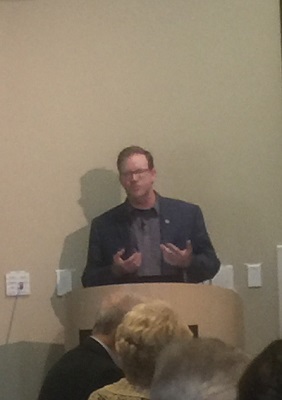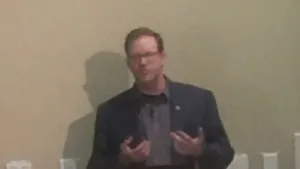At the end of September, in conjunction with National Suicide Prevention Month, I attended a presentation by Matt Vogl, the Executive Director of the National Mental Health Innovation Center (NMHIC) at the CU Anschutz Medical Campus.
Following close on the heels of an August suicide of a nine-year old boy here in Colorado, the speech focused on new innovative treatment options in the mental health arena, with a strong emphasis on the restorative role that can be played by virtual reality and other technologies.
 Dr. Vogl speaking at the the University of Colorado-Denver on the topic of technology innnovation and mental health
Dr. Vogl speaking at the the University of Colorado-Denver on the topic of technology innnovation and mental health
Dr. Vogl began his talk by lamenting the dysfunctionalities of mental health treatment in the current decade: ”Only 20% of people with mental illness get the adequate care they need—80% receive limited or no care at all.” He worried, “Mental health today is built on a sixty-year old model, [a poorly funded] crisis treatment model“, adding “and we can’t just clinic our way out of it.” He continued: “We can add psychiatrists, and beds, but then these facilities just fill up again with [growing] waiting lists.”
Dr. Vogl formed the National Mental Health Innovation Center to deal a direct blow to the weaknesses inherent in the traditional model of mental health treatment. The National Mental Health Innovation Center has two primary goals. Their first purpose is to redefine and expand the mental health workforce, bringing more allies and mental health partners to the table. (An example would be supporting traveling social-emotional learning (SEL) museum displays, focusing on the emotions from the Disney cartoon movie, Inside Out.)
The second priority for the NMHIC is to expand the use of technology and innovation in mental health. And that’s where things started to get interesting. Starting with a description of some recent experiments with virtual therapy on astronauts, Vogl touted the success of virtual therapies on two simulated Mars missions. Evidently astronauts demonstrated greater honesty, and scored higher on six of eight domains, when speaking with a virtual therapist as opposed to a physically present therapist. He also described two promising mental health support technologies on the horizon:
- Ellipsis Health. This Silicon Valley-based company is developing voice-recognition software to diagnose depression and anxiety. So far they are achieving around 90% accuracy in diagnosis, but are pushing for higher percentages before releasing their product.
- Equility. This Seattle-based startup is trying to replace an expensive treatment option for dealing with pain and stress management: vagus nerve electrical stimulation. The traditional technique implants an expensive and invasive device; but Equility has developed a sleeker device (currently seeking FDA approval) that inserts into the ear that is more effective, language agnostic and should be available to consumers for well under $500.
Vogl then moved the conversation towards the role of virtual reality and immersive environments in supporting mental health goals, reminding the audience that “in the treatment and prevention in mental health, there’s over 30 years of research on the effectiveness of VR.” He quickly highlighted some recent use cases:
Fear Management. VR can be used to reduce or eliminate phobias (e.g., fear of heights, flying, public speaking or spiders) through gradual exposure to a phobia and learning incrementally how to manage one’s fears. For example, using VR, one can overcome the fear of speaking in public by practicing a speech at a simulated conference table, moving on to a classroom, then a big hall, and even the giant auditorium.
PTS (post traumatic stress) and PTSD. Returning from two tours in Iraq, a veteran’s debilitating PTSD condition was addressed using the Virtual Iraq simulation. Using VR, therapists discovered the exact trigger for his panic attacks, and then treated him for six weeks until he reliably overcame the trigger and got well. The key notion involved here is called “exposure therapy”: a patient – guided by a trained therapist – confronts their trauma memories through a retelling of the experience. Exposure therapy, is now endorsed as an “evidence-based” treatment for PTS. (See BraveMind VR Exposure Therapy. It is used in mental health and primary care centers to help providers recover from traumatic experiences, not just patients or victims.)
Hospice Treatment. VR has been used in end-of-life hospice care to allow patients to check off some of their “bucket list” regrets. Vogl related one story from England in which a dying patient, after using VR to visit a longed-for experience, confessed: “I feel I can let go now, because I finally saw the Great Barrier Reef. “
Addiction Recovery. Traditionally done with sterile face-to-face role playing, with VR, recovering addicts can be environmentally situated in virtual parties, dingy dens, bars, and heroin tables to practice their avoidance and refusal skills.
Pain Management. Based on work coming out of the University of Washington, VR has been successfully employed in a pediatric burn unit for pain management. Patients experiencing the SnowWorld simulation have experienced a 42% reduction in pain, with no other medications in use, at all. See the video below:
Violence, Suicide and Recidivism Prevention. In Alaska, the long and dark winter days (with darkness prevailing 23 hours a day) are unforgiving. Suicide rates and criminal recidivism spike. In Alaskan prisons, violence and attacks go up, while anxiety for prison guards and inmates is high. “Violence in prisons is typically dealt with by the use of isolation or drugs, which are counterproductive, and make matters worse”, according to Vogl. Dr. Vogl highlighted VR meditation experiences, now being developed by the likes of Samsung and NYC-based NSENA, allow both inmates and guards to mellow and meditate on sunny beach in the dead of winter. On the recidivism issue, Vogl mentioned that VR simulations currently allow prisoners to prepare for their eventual release by practicing every day tasks such as doing laundry, managing their personal space, and practising conflict resolution. He also highlighted the role of VR in allowing inmates to practise job interviewing skills. All, according to Vogl, were more effective conducted in VR than in face-to-face formats.
Empathy. In an interesting departure from mental health treatment, Dr. Vogl also weighed in on the VR as empathy builder issue. He noted that, after the development and use of a VR walkthrough of a Syrian refugee camp, charities noticed a 300% increase in giving. And street representatives, pushing for donations on sidewalks, with VR headgear in hand, witnessed a doubling of gifts over those without the VR experience. Interesting—Len Scrogan
This article was originally published behind our paywall for subscribers, but we thought it deserved a wider audience so have ‘liberated’ it! (BR)

